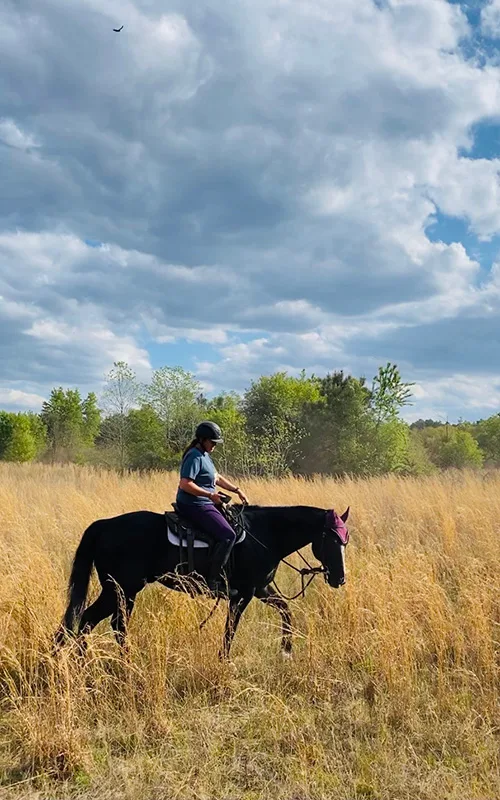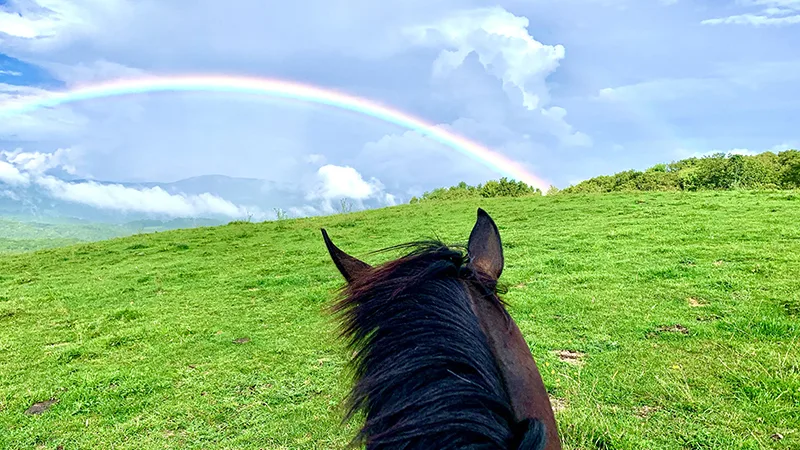There’s a scene in my favorite movie of all time—you know the one—where Princess Buttercup has flung herself off of a ship into screaming-eel-infested water while Vizzini shouts orders at his brute forces to grab her.
“I only dog paddle,” Fezzik meekly says, when he is directed to jump in the water to snatch up the slowly escaping princess.
I think of this scene every time I meet someone who ends up asking the question, “Oh, you ride? What kind of riding do you do?”
…I only dog-paddle.
I only dog-paddle.
I only dog-paddle…
“Nowadays, I really only trail ride.”
I usually expect that endearing, sorrowful “there, there, little lady” look creep across the face of the asker—as if I’m too chicken to event anymore, or too decrepit to train seriously, or too chair-seated to trot down a centerline ever again.
That used to bother me, to tell the truth; now I realize they just don’t get it.
They don’t understand what real trail riding is—the challenge to me mentally, physically, emotionally—not to mention the same challenges my horse is facing. They don’t see the days and days and days of training I put on my lowly “trail horses” in order to keep us both safe. They don’t see the hours I spend communicating with an animal from its back in order to teach it to trust me and convince it to move how and when I ask and vice-versa—my horse teaching me to trust its feet, its eyes, its desire to keep us both safe.
They see me as a backyard rider in mismatched tack, walking around my horse community for 20 minutes and marking off my calendar as having ridden that day.
I know better, and that gives me a giggle nowadays.
ADVERTISEMENT
I was lucky to have grown up in Maryland, smack dab in the center of horse activities. Foxhunting and hunter/jumper/equitation was my lifeblood as a kid, each teaching me respect for land, how to learn, how to teach, how to put my heels down and eyes up. My greatest joy, though, was trail riding through the valley of the Seneca Creek tributaries near the little farm in Germantown where I was lucky enough to pay for my very own horse by cleaning stalls.
I was a young adult before I stumbled into what I now call “for-real trail riding.” In the infancy of the internet, I’d joined a Maryland horse listserv that connected me with horse people all over the state. Before long, I found myself meeting up with these kind strangers and learning how to really ride outside—how to for-real trail ride.

Blogger Allie Conrad has rediscovered ‘for-real trail riding’ with her off-the-track, stakes-winning Thoroughbred Bettys Bambino. Photos Courtesy of Allie Conrad
I was young and bendy and had too much energy to realize that riding my wild, skinny, fresh-out-of-the-auction-pen racehorse with a bunch of gaited horses at this neat little riding club called “The League of Maryland Horsemen” was probably not the greatest introduction to for-real trail riding, but I didn’t know any better.
They gaited, I trotted. And trotted. And trotted. And cantered. And walked and trotted some more.
Upwards of eight hours we’d go, through rivers, over hills, down railroad tracks. We’d trailer all over and meet up for group rides in places I’d never heard of. I loved every minute of it—the discovery of new places and new people.
Those ladies taught me how to high-line my horse. They taught me how to safely cross high river water. They taught me that you need to pack a sponge to cool off my always-trotting horse in the creeks and a lunch for me and some emergency medical equipment for both of us. They showed me why I needed properly fitting tack for these super long hours in the saddle. They told me to “protect my bits” with baby powder and the right underwear and a sheepskin seat saver. They showed me how to pitch a tent next to my high-lined horse so we could sleep safely next to one another. They showed me how to cook for groups of strangers and how to enjoy the varied personalities I would come across while trail riding. They taught me to encourage my horse to eat grass at breaks and how to safely tie my horse to the police station railing while we got burgers and fries in Sykesville after a four-hour trot to get there.
Often, I was one of only a couple people using English tack and a helmet, but none of that mattered to me or anybody else. We were all out there to enjoy the land on our benevolent horses with the company of other horsewomen (and occasional man, of course).
I look back at the things those ladies taught me—an English-riding 20-something kid who thought she knew it all—and realize I was truly a neophyte. The core of what they did for me, however, was ignite a passion for exploring endless new territory with a trusty steed underneath me.
I spent the next 20 years helping racehorses transition from the track, which ate up any and all spare time I had. I rode my own horses sporadically and dabbled in eventing (poorly), worked an office job, worked on my photography, moved my life to North Carolina, bought a farm, bought a different farm, and built it from the ground up in order to be near the Moss Foundation in Southern Pines, North Carolina.

Sometimes, the view from the top is extra magical: Seeing the world between Betty’s ears near the summit of Mount Rogers in southern Virginia.
Eventually I started trail riding daily again, but the true trail riding I’d experienced in Maryland went the way of the flip phone. I’d see it sometimes, but mostly I had moved on watching while friends evented and going for my moseys around the foundation.
That pull of real riding—real trails that required thinking and planning and fitness work—it tugged at me though.
I couldn’t believe my luck when I learned, while having a conversation with some friends who shared my Jack Russell obsession, that they loved horse camping and trail riding, too.
ADVERTISEMENT
“And hey,” they said, “Why don’t you join us in the mountains and we’ll show you what real trail riding in North Carolina is.”
I. Was. Geeked.
I buried all of the anxiety of worrying about whether we’d get along traveling together or what I would cook for the group and piled my horse Bettys Bambino, my husband and three dogs into my truck and gooseneck. Three hours later, we pulled into Leatherwood Mountain Resort in North Carolina’s Blue Ridge Mountains.
My friends kept telling me the riding was intense and my horse needed to be fit. I thought I understood.
Turns out I didn’t know. I truly didn’t know.
Betty and I followed these fearless women up the steepest hills we’d ever climbed, with edges dropping away just inches from our bodies. At one point, I was leaning forward holding onto Betty’s neck while he (yes, Betty is a gelding) cantered up the cliff we were climbing. Each canter stride propelled us 3 or 4 feet up the grade, my feet dangling behind the saddle closer to his stifles than his girth as he tried to figure out how to use his hind end to motor his former race horse self up a real hill instead of the track at Santa Anita.

Conrad and Betty share a congratulatory snuggle after powering through some of the steepest terrain either had experienced in North Carolina’s Blue Ridge Mountains.
Wowza. I didn’t know.
But I learned real quick, and I was hooked. So was Betty.
The feeling of sitting on a horse who realizes he has a hind end and can use that to push up a hill instead of pull himself up it with his front end? I suspect it’s something akin to that first moment your horse understands how to truly jump, or truly come through it’s back when you ask.
Feeling the horse under me power up hills without tiring, ears pricked, hungry for more at the top—it’s a feeling akin to eventing cross-country when your horse hunts the flags, or hunting behind a pack of hounds in full cry. It’s a 10 on the halt you’ve been working on. It’s Rox Dene at Upperville.
Full-body chills.
And like all of those moments we chase again and again—the feeling of accomplishment we all feel when everything comes together and the horse is sound and the truck doesn’t make a funny noise and work can let us go for a few days—I go “for-real trail riding,” and I can absolutely say it’s not dog-paddling.














